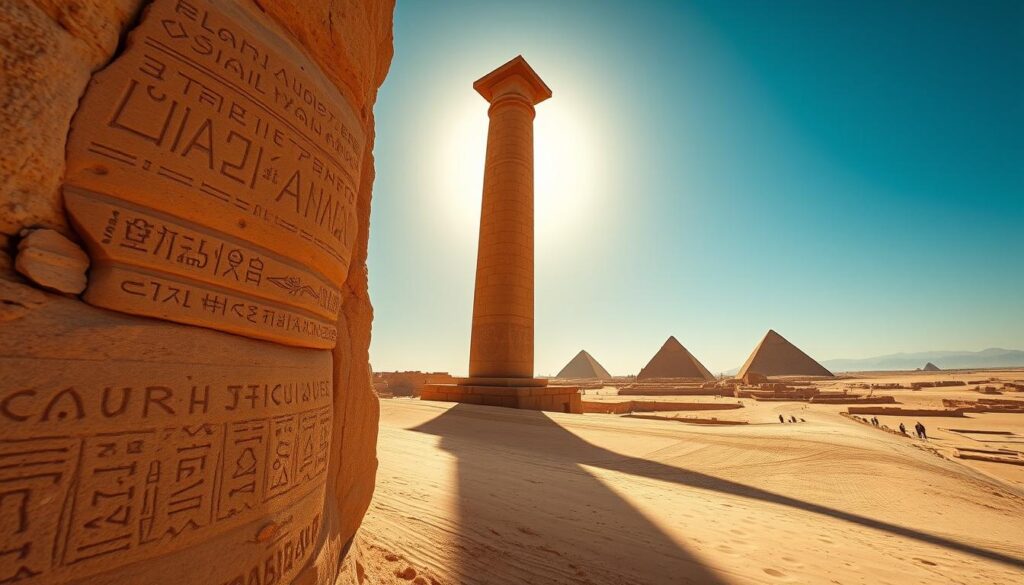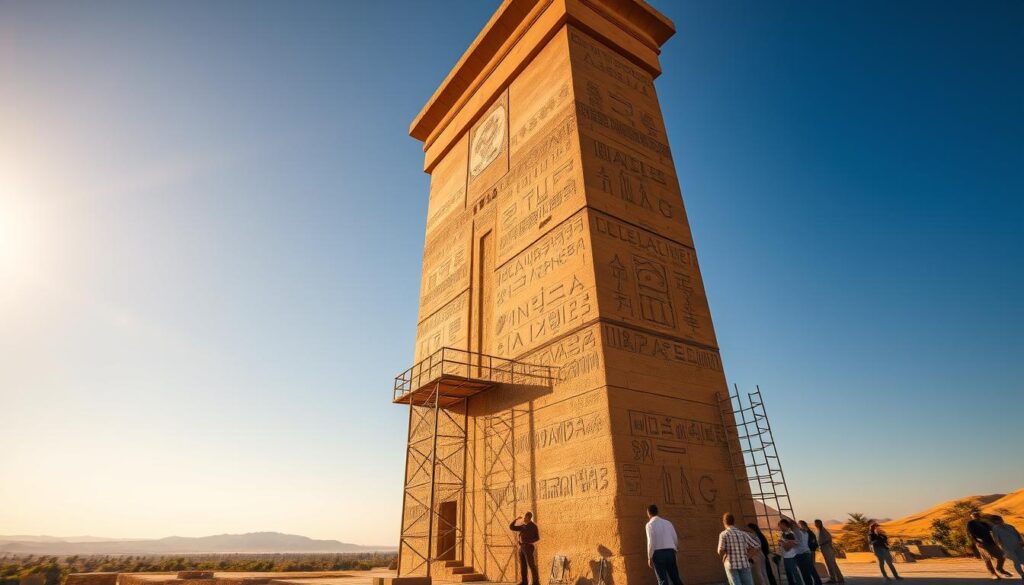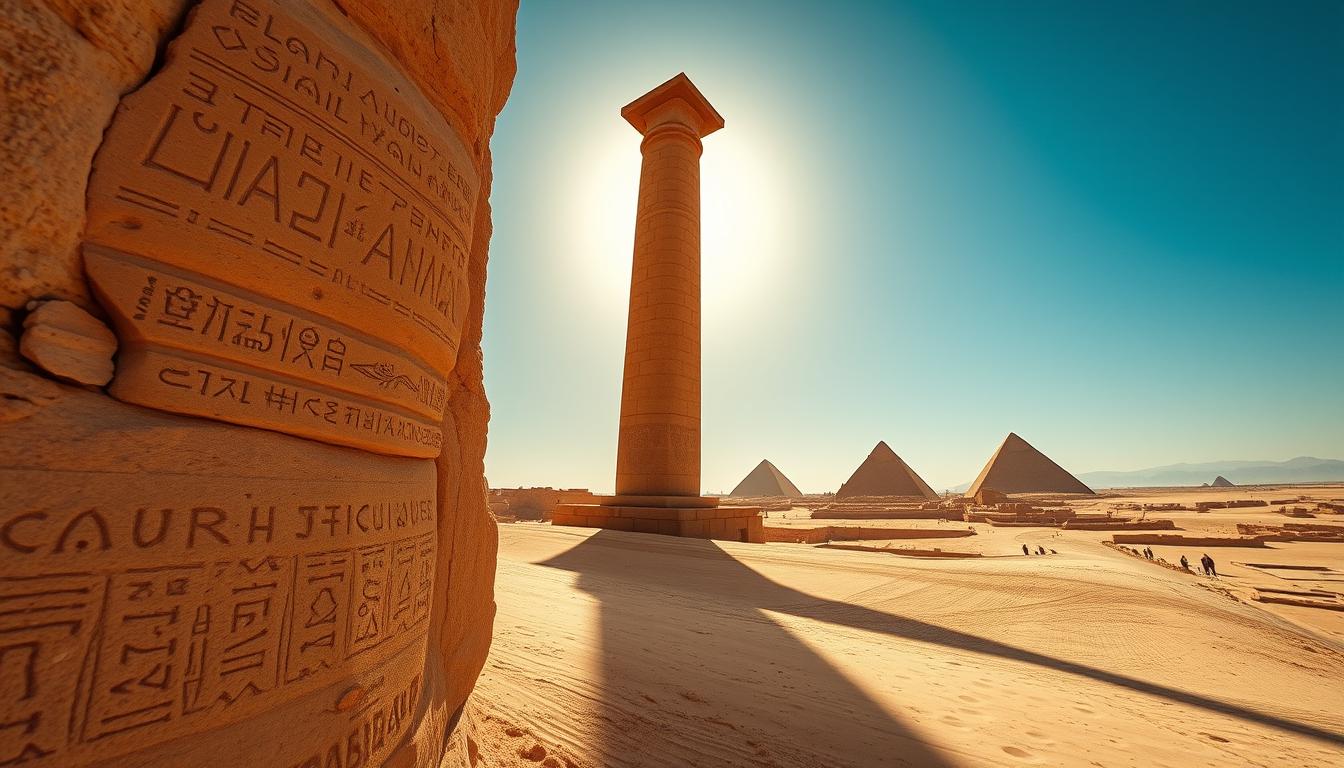The singing stone pillar in Egypt is a fascinating ancient monument. It’s known for its mysterious and melodic sounds. Located in Egypt, this unique structure has captivated people for centuries.

The singing stone pillar in Egypt is an ancient structure full of mystery. Its singing sounds have caught the interest of many. It’s a must-visit for those who love ancient Egyptian monuments and mysterious landmarks.
Key Takeaways
- The singing stone pillar in Egypt is a unique ancient structure known for its melodic sounds.
- It is one of the most fascinating ancient Egyptian monuments, attracting visitors from around the world.
- The Singing Stone Pillar in Egypt is shrouded in mystery, with its singing sounds being a subject of interest for many.
- It is a popular destination for those interested in ancient Egyptian monuments and mysterious landmarks.
- The Singing Stone Pillar in Egypt continues to captivate people’s imagination, making it a must-visit destination.
- Visitors can experience the mysterious and melodic sounds of the Singing Stone Pillar in Egypt, making it an unforgettable experience.
The Ancient Mystery of Egypt’s Musical Monument
The Singing Stone Pillar in Egypt has fascinated people for centuries. Its acoustic phenomena have captured the world’s imagination. Located in a famous archaeological site in Egypt, it remains a mystery. Exploring ancient Egyptian history reveals clues about its significance and role in myths.
Historical records and early Western accounts offer insights into its past. Key findings include:
- Depictions of the Singing Stone Pillar in Egypt in ancient texts, showing its importance in Egyptian culture and history
- References to the pillar in Egyptian mythology, suggesting its role in ancient rituals and ceremonies
- Accounts from early Western travelers, who were amazed by the pillar’s unique acoustic phenomena
Historical Documentation of the Phenomenon
Research on ancient Egyptian references to the pillar has shed light on its historical significance. It reveals a rich and complex history spanning thousands of years. By examining these references, we can understand the Singing Stone Pillar’s role in ancient Egyptian history and its ongoing fascination.
Location and Physical Description of the Singing Stone Pillar in Egypt
The Singing Stone Pillar in Egypt, a place full of history and ancient monuments. It’s a must-see for anyone interested in tourist attractions in Egypt. This structure shows Egypt’s skill in building and its importance in Egyptian culture.
It’s located near other historical sites, giving a peek into Egypt’s past. The pillar stands out with its unique design, unlike other ancient Egyptian buildings.
Some key features of the Singing Stone Pillar in Egypt include:
- Unique acoustic properties that produce a singing sound
- Intricate carvings and hieroglyphics that adorn its surface
- A strategic location that provides a glimpse into the country’s historical significance
Visitors can dive into Egypt’s lively Egyptian culture by seeing the many tourist attractions in Egypt. The pillar is close to other ancient monuments. It’s perfect for those wanting to explore Egypt’s rich history.
The Science Behind the Singing Phenomenon
The Singing Stone Pillar in Egypt’s singing is a complex acoustic phenomenon. It has puzzled many scientists and visitors. To grasp this, we must explore the scientific explanations behind the sound.
Studies reveal that wind passing through the stone creates the sound. This is influenced by environmental factors like temperature and humidity.
Several factors play a role in producing the sound:
- Wind speed and direction
- Temperature and humidity levels
- Stone structure and composition
Similar Acoustic Phenomena Worldwide
There are other acoustic phenomena worldwide similar to the Singing Stone Pillar in Egypt. These include:
- The Great Stalacpipe Organ in Virginia, USA
- The Singing Sands of Nevada, USA
- The Musical Stones of Scotland
Historical Significance in Ancient Egyptian Culture
The Singing Stone Pillar in Egypt is a special part of ancient Egyptian culture. Its sound is thought to have spiritual and mystical powers. Researchers at archaeological sites have found clues about its role in myths and daily life.
This pillar is linked to ancient Egyptian rituals and ceremonies. It’s believed the sound helped talk to gods and had healing powers. The pillar’s importance shows us a lot about ancient Egyptian culture and its people.
Some key points about the Singing Stone Pillar’s historical significance are:
- Its role in ancient Egyptian mythology and folklore
- Its use in rituals and ceremonies
- Its association with spiritual and mystical properties
- Its significance in archaeological sites and historical records

Studying the Singing Stone Pillar has revealed its importance in ancient Egyptian culture. By looking at its role in myths, rituals, and daily life, we learn more about ancient Egyptian values and beliefs. The Singing Stone Pillar is a captivating subject, giving us a unique look into ancient Egyptian culture and its people.
Visitor’s Guide to Experiencing the Musical Marvel
The Singing Stone Pillar is a top tourist attraction in Egypt. It’s perfect for those who love history, mystery, and natural wonders. To enjoy your visit, plan well. Think about the best times to go, how to get there, and where to stay.
A good visitor’s guide makes visiting the Singing Stone Pillar easier. The best times to visit are spring or autumn. The weather is nice, and there are fewer people around.
- Car rental: A convenient way to explore the surrounding area and get to the Singing Stone Pillar
- Public transportation: A more affordable option, with buses and taxis available from major cities
- Guided tours: A great way to learn more about the history and significance of the Singing Stone Pillar, with transportation included
For accommodations, you have many choices. You can pick from luxury hotels to cozy bed and breakfasts. Always book early, especially when it’s busy, to get a room.
Preservation Efforts and Current Status
The Singing Stone Pillar in Egypt is a unique and fascinating ancient monument. It needs careful preservation efforts to keep it intact for the future. Conservation challenges like erosion and human impact are big concerns. To tackle these, many research projects are working on preservation strategies.
Some important preservation efforts include:
- Environmental monitoring to track changes in temperature, humidity, and other factors that may affect the pillar’s condition
- Conservation treatments to stabilize and protect the stone surface
- Education and outreach programs to raise awareness about the importance of preserving the Singing Stone Pillar
Ongoing research projects are exploring new ways to preserve the pillar. This includes using advanced materials and techniques. By supporting these preservation efforts, we can help the Singing Stone Pillar last for a long time.

Together, we can protect the Singing Stone Pillar. This way, we ensure its cultural and historical value for future generations.
Legends and Folklore Surrounding the Stone
The Singing Stone Pillar is wrapped in a rich mix of legends and folklore. These stories come from ancient Egyptian mythology. They have been shared for generations, captivating people everywhere.
These tales often talk about the pillar’s power to heal, protect, and bring luck. People believe its sound has magical powers. It’s said to keep evil away and draw good vibes. These ideas come from ancient Egyptian mythology, where special objects were thought to have powers.
Looking into these legends and folklore shows a complex cultural scene. The Singing Stone Pillar is more than a natural wonder. It’s a symbol of the area’s rich culture. By exploring these stories, we learn more about the pillar’s charm and its place in people’s hearts.
Exploring the legends and folklore of the Singing Stone Pillar reveals a rich tapestry of myths. These stories show the region’s cultural identity. They also show our universal quest to understand and connect with nature’s mysteries.
Modern Scientific Studies and Discoveries
In recent years, modern scientific studies have greatly increased our knowledge of the Singing Stone Pillar. These studies have helped us understand how it was built, its purpose, and the science behind its sounds. By combining archaeological findings, acoustic research, and geological analysis, researchers have made big strides in understanding this ancient wonder.
Some of the key discoveries include:
- Advances in acoustic research have helped scientists understand the precise mechanisms behind the pillar’s unique sound production.
- Archaeological findings have provided valuable insights into the pillar’s construction and historical context.
- Geological analysis has shed light on the composition and properties of the stone used to build the pillar, which has implications for its durability and preservation.
Thanks to these modern scientific studies, we now admire the ancient civilization’s ingenuity and skill. As research keeps uncovering new facts, we might find even more secrets in this ancient marvel.
Cultural Impact and Artistic Inspirations
The Singing Stone Pillar has deeply influenced Egyptian culture and more. It has inspired many art, literature, and music pieces. Its unique sound has been a source of inspiration for artists and creatives for centuries.
From ancient Egyptian poetry to today’s music, the Singing Stone Pillar’s impact is clear. It has influenced many famous authors, poets, and musicians. They have tried to capture its magical sound in their work.
Some notable examples of the pillar’s influence include:
- Inspiration for musical compositions, such as symphonies and orchestral pieces
- Influence on literary works, including poetry and novels
- Depictions in art, such as paintings and sculptures
The Singing Stone Pillar’s impact is not just in Egypt. It has inspired art and literature all over the world. As a symbol of Egyptian culture, it continues to inspire new artists, writers, and musicians.
The pillar’s role in Egyptian culture is clear. Its influence on art will be felt for many years. The Singing Stone Pillar is a key part of Egypt’s cultural heritage.
Conclusion: The Enduring Mystery of Egypt’s Musical Monument
The Singing Stone Pillar in Egypt is a true marvel. It has a singing phenomenon that draws people from all over. Its historical significance and cultural impact make it a source of endless wonder.
Many have tried to understand the Singing Stone Pillar. Scientists and historians have studied it for years. They aim to figure out how it makes such amazing sounds.
Its allure will keep drawing in new explorers and scholars. As we learn more, we see the power of curiosity. It shows us the endless wonders waiting to be discovered.
FAQ
What is the Singing Stone Pillar?
The Singing Stone Pillar is a mysterious ancient structure in Egypt. It makes eerie, melodic sounds that have amazed people for centuries.
Where is the Singing Stone Pillar located?
It’s in Egypt, a place famous for its ancient history and monuments.
What is the historical significance of the Singing Stone Pillar?
It’s very important in ancient Egyptian culture. Its sounds are thought to have spiritual and mystical qualities. For centuries, it has fascinated people, with many accounts of its mysterious past.
How does the Singing Stone Pillar produce its sounds?
Scientists and visitors are still trying to figure out how it makes sounds. The sound changes with wind, temperature, and humidity.
Are there any similar acoustic phenomena worldwide?
Yes, there are other “singing” rocks and monuments around the world. They make sounds like the Singing Stone Pillar.
What are the current preservation efforts for the Singing Stone Pillar?
Keeping the Singing Stone Pillar safe is very important. There are ongoing research and conservation efforts to protect it for the future.
What kind of legends and folklore surround the Singing Stone Pillar?
Many legends and folklore surround it, showing its importance in ancient Egyptian mythology. These stories are full of mystery, making the pillar even more fascinating.
How has the Singing Stone Pillar influenced art, literature, and music?
It has inspired many artists, writers, and musicians. It has been a source of inspiration for centuries, showing its lasting impact on culture.
Source link
